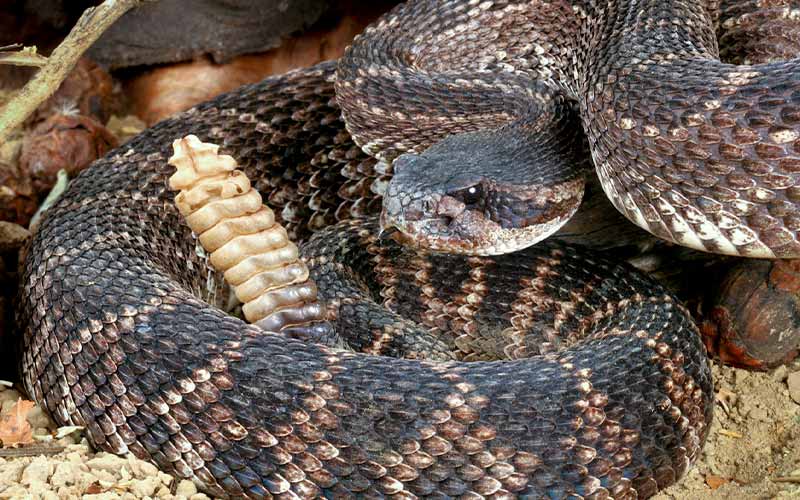As divers, we dutifully learn to treat the bites and stings of a variety of animals from around the world, including jellyfish, lionfish, fire coral, sea snakes and cone snails. But we may not be as familiar with the venomous creatures we’re more likely to encounter close to home.
Snakes
In North America there are two general types of venomous snake: pit vipers and elapids. Pit vipers, also called crotaline snakes, are the continent’s most common venomous snakes. The name pit viper comes from special heat-sensing organs the snakes have. These organs, deep pits near the snakes’ nostrils, allow the snakes to “see” the heat radiating from their prey. Rattlesnakes, copperheads and cottonmouths are the three major types of North American pit vipers.

There are more than 30 species of rattlesnake, and all are endemic to the Americas. They are common across the continents, ranging as far north as British Columbia and Alberta. Of the dozen or so fatalities due to snakebite that occur in North America each year, rattlesnakes are responsible for about 80 percent of them. Cottonmouths, also called water moccasins, are found throughout the southeastern U.S., where they live near swamps, streams and ponds. They are known for their threat displays; males of the species tend to be territorial and display a gaping behavior, opening their mouths toward intruders to expose light-colored tissues, giving rise to the common name “cottonmouth.” Copperheads are not particularly aggressive but will strike when provoked. Unlike rattlesnakes, which often coil to strike, or cottonmouths, which tend toward territorial displays, copperheads frequently lie still when encountered. This behavior likely evolved because of their excellent camouflage.
Coral snakes are the only North American representatives of the elapidae family, which includes the most deadly venomous snakes in the world: cobras, kraits, taipans and sea snakes. Like all elapids, coral snakes produce a potent, neurotoxic venom that is very different from the primarily hemotoxic, cytotoxic and myotoxic venom of the pit vipers. North American coral snakes are generally smaller than pit vipers (typically about 2 feet long) and have a distinctive red, yellow and black banded pattern. This pattern closely resembles that of several other nonpoisonous snakes, but there is a key difference. The rhyme, “Red on yellow, kill a fellow; red on black, venom lack” is reliable, at least in North America, for distinguishing coral snakes from nonpoisonous species. If the red bands touch the yellow bands, stay away. Despite the toxicity of the coral snake’s venom, the incidence of injury is very small. The snakes are timid and prefer to stay out of sight, underneath rotting logs or stones, for example.

In North America snakebites occur primarily because people accidentally step on snakes or intentionally provoke them. Alcohol intoxication is commonly associated with snakebite, particularly bites in which the person was attempting to capture, kill or antagonize the snake. If someone has been bitten by a snake, no matter whether there are symptoms or not, wash the wound with soap and water. Stay clear of the snake, and do not attempt to capture it. Keep the victim calm and still. Victims should be evaluated by a doctor as soon as possible, but they should not walk or exert themselves if it can be avoided. Venom can cause swelling, pain, weakness, numbness, nausea and vomiting, but it is worth noting that approximately one quarter of bites by venomous species are dry, which means no venom is delivered. Prepare for swelling by removing watches, rings or other jewelry. Splint the extremity to minimize movement. Although many different folk remedies have been recommended for treating snakebites, most are not helpful, and many are dangerous. Never cut, suck or apply ice, heat or electricity. Coral snake bites warrant the same treatment, with the addition of a pressure immobilization bandage on the entirety of the affected limb. A wide elastic bandage (such as an ACE wrap) should be applied, starting at the extremity and wrapping toward the core. Coral snakes’ neurotoxic venom can cause respiratory failure in a matter of hours, so artificial or mechanical ventilation may be required to save a person’s life. Antivenom, if available, may also be an important component of snakebite emergency care.
Arachnids
In North America severe scorpion envenomations come from a single genus, Centruroides, commonly known as the bark scorpions. Bark scorpions are actually among the smaller scorpions to be found in the North America, but their venom is much more potent than that of the continent’s other scorpions. Stings are immediately painful and can cause redness, swelling, numbness and tingling. Nausea, vomiting and incontinence are also possible.

Of the spiders that inhabit North America, two stand out as the most dangerous. Widow spiders, so named due to a penchant among some females of the genus to eat the male after mating, are one of them. Widow spiders, including the common black widow, can be found in moist, dark places such as the crawl spaces of homes. Widow spiders sometimes have a red hourglass symbol on them, but it may appear as two red dots. Recluse spiders are infamous for their dermonecrotic bites that cause serious skin lesions. The fear these spiders induce leads to them being blamed unfairly for a number of ugly skin problems. Various wounds, burns, infections and diseases are often mistaken for brown recluse bites. One expert estimated that 80 percent of suspected brown recluse bites are actually misdiagnoses.
Bites and stings by North American spiders and scorpions are rarely serious, typically no more severe than bee stings. Clean wounds with soap and water, then apply ice or cool water. Closely monitor anyone who has been bitten by a spider or stung by a scorpion, and seek immediate medical attention if serious symptoms occur. These may include blurred vision, difficulty swallowing and cardiovascular or respiratory distress.
Ticks aren’t feared the way their larger relatives spiders and scorpions are, but, in North America at least, they present a greater hazard. Ticks carry Lyme disease, babesiosis, Rocky Mountain spotted fever and many other diseases. Fortunately, ticks often crawl around on the bodies of their prey for several hours before attaching, and even after attaching they need about 24 hours to transmit disease. Thus, thorough tick checks, ideally by another person, should be conducted twice daily when in tick country. The scalp, armpits and groin warrant particular attention. To remove a tick, simply grasp it firmly with tweezers or gloved fingers close to the victim’s skin and pull it directly out. Attempts to burn, smother or twist are unnecessary and may create problems. Wash the site after removing the tick, and keep an eye out for any unusual symptoms. Report them to a doctor if they occur. Long pants, long sleeves, a hat with a brim and insect repellent at the cuffs can help reduce the risk of tick bites.
Insects
Bees, wasps, fire ants and hornets (order Hymenoptera) are well known for the painful stings they can deliver. While the venom of a single individual is not generally potent enough to cause severe symptoms, multiple stings that might result from disturbing a hive or encountering a swarm could deliver enough venom to cause a headache, nausea, fever or dizziness. The real concern with these insects, however, is the potential for a serious allergic reaction. Anaphylaxis will occur following a bee sting in 1 to 3 percent of the population. Anaphylaxis is a severe allergic reaction in which the airway begins to swell shut, impairing breathing, while the blood vessels dilate, lowering blood pressure to dangerous levels. As an allergic reaction, anaphylaxis is not directly due to a given harmful substance; rather, it is an inappropriate response to the substance by the affected individual’s own immune system. Some people’s immune systems are ill-equipped to handle envenomation by these insects — each year about 50 (and sometimes more than 100) people die from anaphylaxis following Hymenoptera stings.

If someone with a known allergy is stung, he or she should have the necessary medication available. First, the stung individual should take an antihistamine such as diphenhydramine (Benadryl). This type of medication dampens the body’s inappropriate and dangerous response to the offending substance and is the definitive treatment. If the person is unable to swallow the antihistamine, he may require immediate injection with epinephrine, which can reopen a swelling airway and reconstrict dilating blood vessels in a matter of seconds. Prompt administration of this drug can be lifesaving. Signs it is appropriate to administer epinephrine include difficulty breathing or swallowing, large areas of swelling and signs of shock (pale, cool skin; weak pulse; rapid respirations). In the absence of any signs of anaphylaxis, a dose of epinephrine may be wasted if given too early or unnecessarily. If you’re in a remote location and have a limited amount of the medication, timing is important.
Mammals
Despite the fact mammal bites do not come with a risk of envenomation, they do carry a risk of infection and disease transmission. Wash bites with soap and warm water, and see a physician for an assessment of the need for rabies prophylaxis. Foxes, bats, possums, raccoons, skunks and dogs can all be carriers of the virus. Any mammal that bites a human should be considered suspect. Postexposure prophylaxis consists of five injections over the course of two weeks. This is a small price to pay considering the symptoms of rabies — general malaise progressing to confusion, agitation, abnormal behavior, hallucinations and, within a few days, death. Once symptoms occur, rabies is not generally survivable.
Although the presence of creepy-crawly things that bite is often given as a reason some people don’t like to spend time outside, in North America, at least, the chances of being seriously injured by envenomation are extremely small. Understanding why bites and stings occur, how to recognize and evaluate the symptoms and how to treat them can ease minds and improve confidence for venturing into the outdoors.
© Alert Diver — Q1 Winter 2012